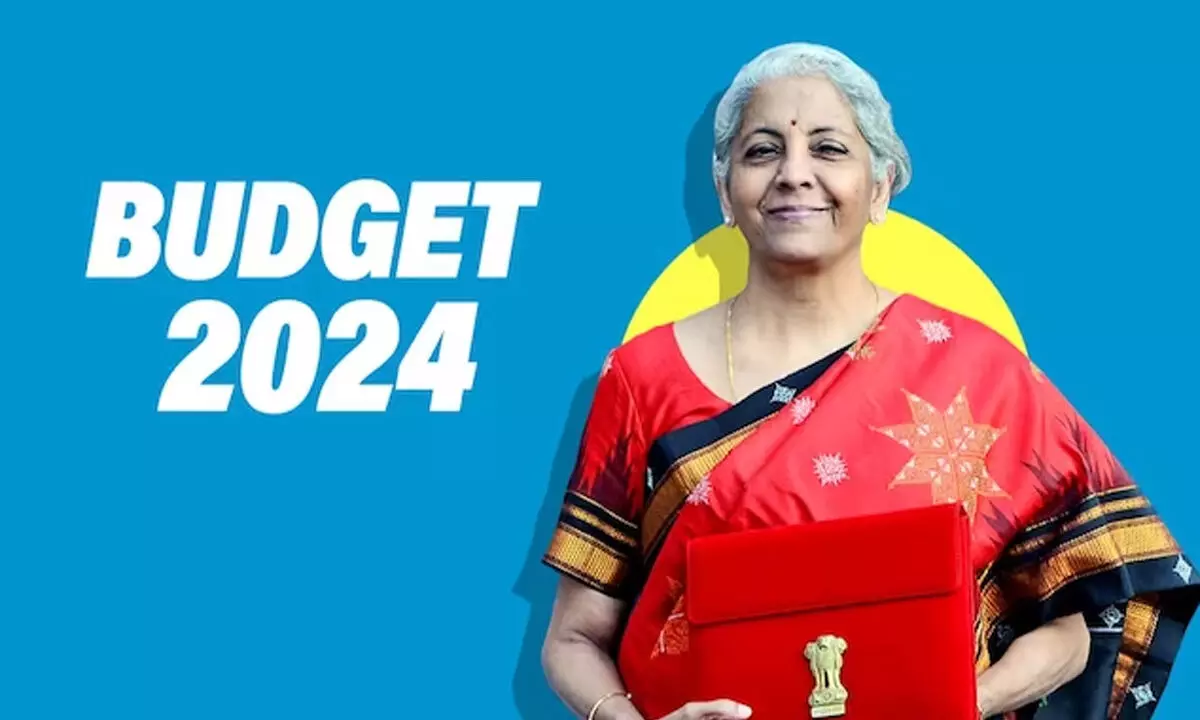Live
- Sudanese army says repulsed paramilitary forces attack in western Sudan, killing over 80
- Jaipur Open 2024: Baisoya makes a grand comeback to clinch title in marathon playoff against Rashid Khan
- Jamaat-e-Islami Hind President asks cadre to reach out to larger society beyond community
- Why PM mum on Caste Census, removing 50 pc quota limit: Rahul Gandhi
- Barrackpore Municipality Vice-Chairman found dead at home, suicide note suggests blackmail
- Selection trials announced for 20th Asian Senior Women's Handball Championship
- Women’s Asian Champions Trophy: India register 3-0 win over Olympic medallist China in Rajgir
- Sr Men's National Hockey: Odisha overcomes Haryana to secure maiden title
- Even Trinamool leaders not safe in Bengal: BJP
- Jumbo deaths: MP govt planning major reshuffle of Bandhavgarh Tiger Reserve staff
Just In
Hopes for a historic budget as FM makes history today


Nirmala Sitharaman will make history on Tuesday, as she presents the seventh consecutive Union Budget, surpassing the earlier record set by Morarjee Desai who had tabled six budgets.
Nirmala Sitharaman will make history on Tuesday, as she presents the seventh consecutive Union Budget, surpassing the earlier record set by Morarjee Desai who had tabled six budgets. It is ardently wished that Sitharaman will also present a historic budget. A billion plus nation is waiting with bated breath for boost to key sectors in the first Budget of the Modi 3.0 era.
On the eve of Budget, speaking of the Economic Survey 2024, she assured the nation that the Indian economy is on a strong wicket, witnessing an estimated growth of 8.2% in FY24. She said the economy would grow at 6.5% to 7% in FY25 as well. The GDP which was $2.04 trillion when Narendra Modi took over the reins of the nation kept accelerating, and is estimated to have grown to nearly $4 trillion in last financial year, a growth of 9.1% over the previous FY i.e., 2022-23. This is despite volatile geopolitical conditions hard-pressing most economies for the past few years.
What imparted such a resilience to the economy? The political stability for the past 10 years has served well to ensure the continuity of economic policy and reforms by the Modi government, be it the Goods and Services Tax, which replaced a complex and fragmented tax structure with a unified tax system; the Insolvency and Bankruptcy Code, a one-stop solution for resolving insolvencies, doing away with existing long, cumbersome procedures; ease of doing business; or, the Jan Dhan Yojana or Direct Benefit Transfer.
It is but natural that a fast-growing economy has raised personal growth aspirations of the citizenry in the most populous country in the world (1.428 billion versus China’s 1.425 bn). As such, after wide-ranging talks with key stakeholders, Sitharaman must have a fair view of the goings-on in key sectors viz., industry, trade and services, capital markets, and last but not the least, agriculture (whose share in GDP decelerated from 35% in nineties to around 15% in FY23. It employs about 46% of total workforce). The immediate demands on FM are to raise capital expenditure, expand infrastructure, address the burgeoning issue of unemployment, both urban and rural, and give a push to the green energy investments. Climate change is the elephant in the room. India has vowed to reduce emissions intensity of its GDP by 45% by 2030, and net-zero emissions by 2070. Thus, the FM has to skillfully overcome challenges, while persisting with means to reduce fiscal deficit – in order to reduce inflationary pressures and avoid lending rate hike. According to global healthcare security index 2021, India ranked 66 out of 195 countries. The country has been ranked 111 among 125 countries by the Global Hunger Index. ‘Lancet’ ranked India at 154 out of 195 countries in terms of access to healthcare, which is worse than Bangladesh, Nepal, Ghana and Liberia. Undernutrition, diseases burden etc., are also concerning. A higher health outlay is definitely needed.
Though the Economic Survey claims that the unemployment rate dropped to 10% from 17.8% between 2017 and 2022, the issue is still troubling millions. Skills deficiency has emerged a major concern for employers and hence the need for thrust to skills development programmes.
Buzz in the market is Sitharaman may pay heed to the cry of the middle class for reduction of tax rates for salaried individuals in the Rs 9 lakh to Rs 12 lakh bracket. It would give an impetus to the urban consumption which is trailing that in rural areas. Rationalising GST would, particularly, boost real estate which shares 7% of GDP and is the second largest employer. Facilitating the growth of MSMEs is another imperative as the sector contributes around 29 per cent to GDP and accounts of 60% of employment. Break a leg, FM. We’re sure you will do great!

© 2024 Hyderabad Media House Limited/The Hans India. All rights reserved. Powered by hocalwire.com






